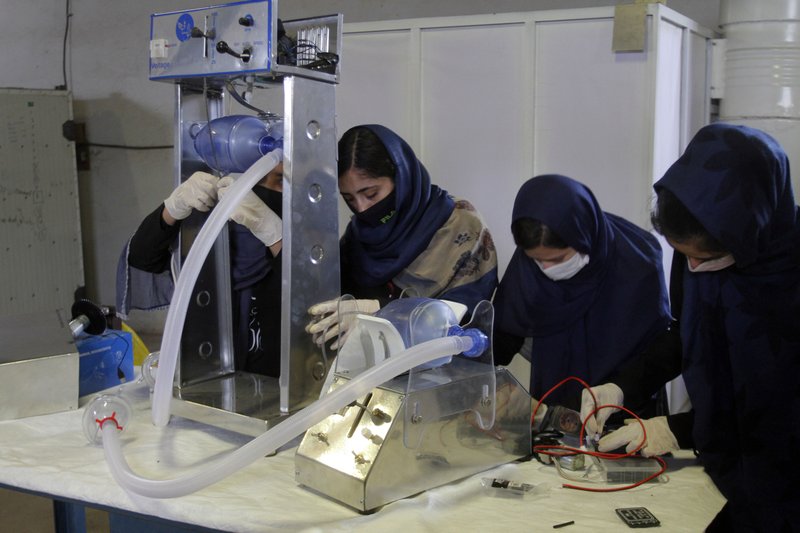In 2020, international media were celebrating the all-female robotics teams in Afghanistan who were building ventilators for COVID-19 patients.
It was incredible to see these women and girls at work, given the massive gains that had to be made just for them to achieve the basic right of an education. Impressively, the proportion of female university graduates had been growing exponentially in Afghanistan.
But what happens to these women and girls now that the Taliban has seized control, and the international community has all but abandoned them? What happens to Afghanistan’s Girl’s Robotics Team, which UNICEF preiously described as just experiencing a year of “opportunities, adventures, and great success” through 2020 as they developed the first prototype ventilator?
The Taliban seized Herat, the home of this girls Robotics Team, three days ago. As I write, they have just taken the largest city, Kabul, where so many female activists and those considered to be the most at risk from the Taliban had fled. The speed at which the Taliban has taken back the country since American and NATO forces withdrew in July has been horrifying to witness.
This is a tragedy that is beyond words or comprehension. Afghan women had fought for the most basic of human rights, and then taken them to get further educated, then to innovate, to build, to lead, to inspire the next generation of girls behind them. They have hopes and dreams and have worked to deliver on them, spurred on by the progress and protections the international community had helped enable. They had used their education to save the lives of fellow Afghans during COVID. They had told their stories of what they had experienced under Taliban rule, recounting the trauma and the horror, possibly in the hope that the rest of us could learn from it and ensure such history would never again be repeated.
But swiftly, the country has fallen and history looks set to repeat, just as Afghan women had feared and pleaded to the international community to help prevent.
There has been a spike in civilian casualties reported in the first half of this year, with women and children making up almost half of those killed. On the 8th May this year, an attack on a school in Kabul left 85 schoolgirls dead. The Taliban have reportedly been going “door to door” to take records of women and girls aged 12 to 45. As far back in July they were already making lists of girls to be “married” to Taliban fighters in the provinces they had already taken. It is unknown if these forced marriages have taken place, but it’s believed those on such lists would be taken from their homes to a location in Pakistan to be converted to “authentic Islam”.
One can only imagine the fear women and girls must be experiencing as the Taliban has now taken control of the Afghan government. Especially the female activists who have courageously come out in support of women’s rights, the schoolgirls attempting to continue their education, the university graduates, those women starting out their careers. These women creating ventilators, who have given so much through their work and education in STEM.
Indeed, despite the ongoing conflict in Afghanistan, massive gains had been made for women – with estimates that 40% of children enrolled in schools are girls, and women taking roles in Parliaments, as local mayors, as police officers, doctors, entrepreneurs.
What becomes of the women who made such success from these gains? For those currently studying and with hopes and dreams about their own careers and economic security? And what about girls, the young teenagers and the next generation behind them?
We know from history what happened previously, under Taliban rule. No girls attended formal schools back in 2001, and just 12.6% of women over the age of 15 could read or write. From 1996 to 2001 when the Taliban previously ruled the country, women were not permitted to work, they could not be in contact with any non-related man, were forced to wear full burqas in public, and faced horrific punishments if they violated these rules: execution, public flogging, torture and imprisonment.
Women’s rights activists, including Mariam Atahi who has advocated for women’s rights for 20 years, told DW she believes the Taliban will kill her if they take Kabul, many others are saying the same thing.
Late last week, Mahbooba Seraj, the founder of the Afghan Women’s Network, had a message for the international community and those who had been in Afghanistan for the past 20 year. “Shame on you.”
“Are we just the pawns in your hands? The fact is we don’t have any hopes from you… The time for talking is over. We talked to you. We demanded. We did everything and nobody paid any attention.
“They made decisions with their gut feelings, all these men of the world, and they destroyed something we have worked so hard for.”
She said the country has been set back 200 years. She said she won’t see anything good become of it now before she is long gone.
On Sunday, Canada announced it will take in 20,000 Afghan refugees on humanitarian grounds, giving priority to the most vulnerable including women leaders and human rights defenders. Will the United States follow with a much more ambitious target, along with every ally? What can we expect from Australia? It is the absolute least we can do right now.
Back in 2001, then US President George W Bush pledged to support women and children in Afghanistan. At the time, his wife Laura told reporters that, “the fight against terrorism is also the fight for the rights and dignity of women”
Twenty years later the world community has not only forgotten, it has betrayed these women.


